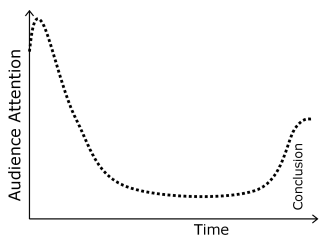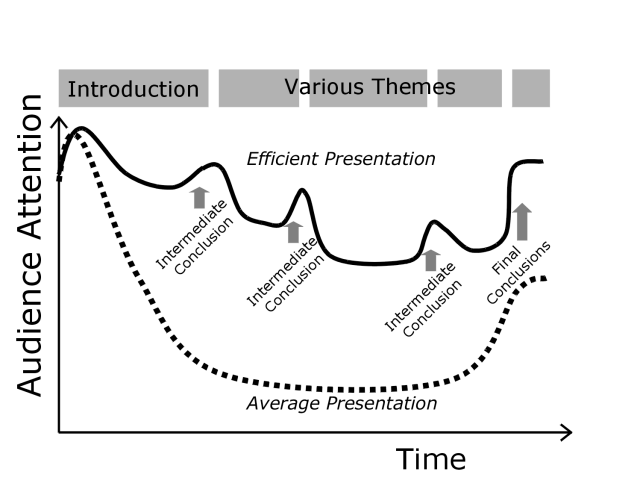How to Give Successful Oral Presentations
Develop your own style, but try to avoid the obvious mistakes.
see also “Presenting Science” on www.catalysiscourse.com
1. Introduction – how many presentations are really useful?
2. The attention curve – help the audience to focus on the message.
3. Why are audiences distracted?
4. How to organize your presentation (and how not).
5. In ten steps to a successful presentation.
6. Conclusion – develop your own style but avoid the common mistakes!
1. Introduction – how many presentations are really useful?
How often have you been listening to oral presentations that dealt with interesting science while you nevertheless had difficulty to pay attention till the end? How often did you lose your interest before the speaker had even come halfway? Was it because of the subject of the talk or was it the way the speaker presented it?
Many presentations concern interesting work, but are nevertheless difficult to follow because the speaker unknowingly makes a number of presentation errors. By far the largest mistake is that a speaker does not realize how an audience listens. If you are well aware of what errors you should avoid, the chances are high that you will be able to greatly improve the effectiveness of your presentations.
Figure 1. Typical attention of the audience pays to an average presentation
Figure 2. Ideal attention curve of an audience when the speaker divides his talk in recognizable parts, each summarized by intermediate conclusions. If people loose their attention for some reason, they can easily catch up with the speaker in one of his intermediate summaries. The big advantage of this approach is that every important item is said several times. Repeating the essentials is the key to getting your message across.
2. The Attention Curve – help the audience to focus on your message.
The average attendee of a conference is by all means willing to listen to you, but he is also easily distracted. You should realize that only a minor part of the people have come specifically to listen to your talk. The rest is there for a variety of reasons, to wait for the next speaker, or to get a general impression of the field, or whatever.
Figure 1 illustrates how the average audience pays attention during a typical presentation of, let’s say, 30 minutes. Almost everyone listens in the beginning, but halfway the attention may well have dropped to around 10-20% of what it was at the start. At the end, many people start to listen again, particularly if you announce your conclusions, because they hope to take something away from the presentation.
What can you do to catch the audience’s attention for the whole duration of your talk? The attention curve immediately gives a few recipes:
- Almost everyone listens in the beginning. This is THE moment to make clear that you will present work that the audience cannot afford to miss.
- If you want to get your message through, you should state it loud and clear in the beginning, and repeat it at the end.
- The best approach, however, is to divide your presentation in several parts, each ended by an intermediate conclusion, see Figure 2. People in the audience who got distracted can always easily catch up with you, particularly if you outline the structure of your talk in the beginning.
3. Why are audiences distracted?
There are many reasons why this may happen, some may be outside your control, such as inadequate sound systems, poor beamers, or noisy conference centers with cardboard walls between two sessions running in parallel. Bad luck if it concerns your talk.
What you can do yourself, however, is avoid anything that may encourage the audience to stop listening. Such mistakes fall in two classes: speaker’s errors and presentation errors.
We list a couple of the most common ones, most are self explanatory.
1. The speaker lives in his own little world of research, he believes that all the background information needed to appreciate the meaning of his work is common knowledge. This is seldom the case! Students often assume that the audience knows as much as their supervisor does, which is definitely not the case! Hence, a subject needs to be properly introduced, depending on the specific audience it is presented for.



